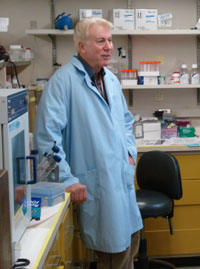Our Science – Farrar Website
William L. Farrar, Ph.D.
 |
|
|||||||||||||||||||||||||
Biography
Dr. Farrar is the head of the Cancer Stem Cell Section, Laboratory of Cancer Prevention. He received his Ph.D. degree from Virginia Polytechnic Institute and State University. He came to the National Institutes of Health as a postdoctoral fellow in 1978 where he developed an interest in defining the role of cytokines in the development of the immune response. Since 1983, he has continued his studies in the lab, elucidating signal transduction pathways associated with cytokines and other endocrine factors.
Research
Much has been learned in the past few years regarding cytokine signal transduction and nuclear receptor mechanisms. Little has been examined concerning how seemingly separate signal systems biochemically interact and modify the biological outcome. Our laboratory has chosen to study this cross-talk with an eye towards raising the possibility of practical molecular intervention in immunological and cytokine driven cancer biology.
The first of our Research Projects, 1) Molecular cross-talk between nuclear receptors and cytokine signal transduction has examined the signal pathways of IL-6 in prostate cancer and multiple myeloma. IL-6 was shown to activate the androgen-receptor(AR) by forming a stable STAT3-AR physical complex. This was an important observation demonstrating the non-steroidal activation of AR by an inflammatory cytokine, suggesting inflammation may promote steroid independence of prostate tumors.
We have studied the signal and molecular pathways by which IL-6 facilitates the growth and drug resistance in human myeloma cells. We identified the STAT3 pathway as a major pathway involved in the growth of these cells and have blocked this pathway by intervening with two different nuclear receptor mechanisms involving the estrogen receptor and PPARgamma, each blocking through differing mechanisms. A large number of tumor cells, including prostate, multiple myeloma, renal cell carcinoma, hepatoma, pancreatic carcinoma, etc. secrete and respond to IL-6. The mechanisms are unknown. We have cloned the 2.1. kb human IL-6 promoter, extensively mutated, and studied the regulation of this promoter in autocrine human prostate carcinoma and multiple myeloma cells. We have identified critical transcription factors for each type of cancer cell line that govern the transcriptional regulation and secretion of IL-6. We are currently developing strategies to molecularly block these transcription factors either genetically or pharmacologically to determine the net effects on IL-6 secretion and the biological response of the tumor cell lines in vitro and in vivo. We also intend to extend these studies to include other IL-6 autocrine tumor cells such as renal cell carcinoma, pancreatic carcinomas and hepatomas. Within the context of this project area, we were the first laboratory to identify the nuclear receptor PPARgamma in human T lymphocytes. We have defined its function as a negative regulator of IL-2 transcription via forming inhibitory complexes with NFAT and NK-kappaB. Furthermore, PPARgamma, is activated by natural ligands produced in macrophages stimulated by IL-4 from Th2-helper cells. These studies have identified a previously unknown regulatory circuit between Th2 and Th1 helper cells.
2) Development of new therapeutic strategies for the treatment of breast cancer. Based on experience in studies on the nuclear receptor ER in our laboratory, the focus of our research has been directed toward the development of new intervention strategies for the treatment of breast cancer at the level of ER DNA binding, rather than classical antagonism of estrogen binding. Estrogen receptors (ER) contain zinc fingers motifs required for their activity. We have discovered that certain electrophilic reagents covalently modify ER zinc fingers resulting in the ejection of zinc and selective inactivation of estrogen receptors. These compounds effectively block estrogen-dependent growth of human breast cancer cell lines in vitro and in vivo. Secondly, we have been able to block the transcriptional activity of ER+ MCF-7 and cell growth by utilizing transcription factor decoy (TFD), demonstrating for the first time that TFD can be used against steroid responsive cells. We will continue our studies of novel ER interventions using tamoxifen resistant ER+ cells in vitro and in vivo and the design of more therapeutically efficacious Zn-finger antagonist.
3) IL-6 regulation of epi-genetic gene silencing. We have shown that IL-6 regulates the transcriptional activity of DNA methyltransferase 1 (Dnmt-1). IL-6 activates STAT3, which in turns, induces transcription of the transcription factor Fli-1, which activates the Dnmt-1 promoter. This year we have focused on identifying targeted genes that are silenced via promoter CpG methylation by IL-6 regulation of gene methylation. So far, using human IL-6 responsive myeloma cells, we have determined that IL-6 induces the promoter methylation of two tumor suppressor genes p53 and p16. Four genes known to participate in base excision repair and nucleotide excision repair have been shown to be silenced, leading to defective DNA repair in these cells. Also, MnSOD was shown to be silenced by promoter methylation in human MM cells. We believe that this demonstrates a foreboding mechanism of how inflammation may govern tumorigenesis by epigenetic silencing of important repair and tumor suppressor genes. We will further attempt to characterize the mechanisms of genomic silencing by inflammation and, in particular, suppression of DNA repair. Additional emphasis will be aimed at understanding the signal transduction process which activate Dnmt-1 and the mechanisms of how specific genes are selected for genomic silencing.
This page was last updated on 6/11/2008.

